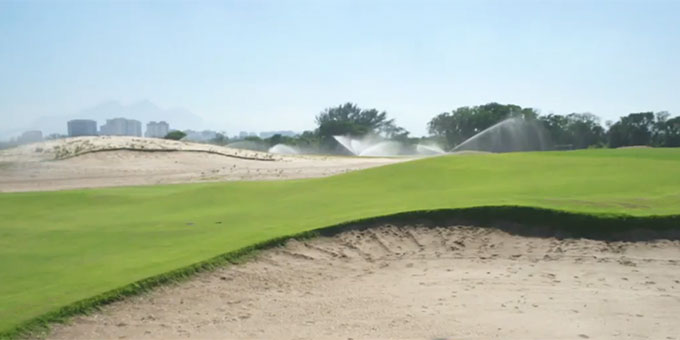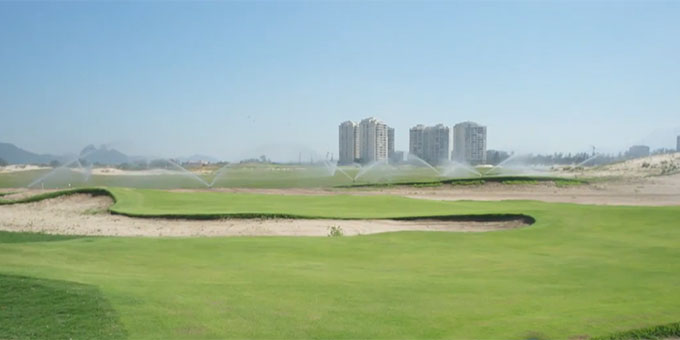Posted on November 6, 2015 in News.
Olympic Games: golf is heading for Rio in 2016!
After a long crossing of the desert for 112 years, golf became an Olympic discipline in 2016. A fair turnaround for a sport that counts more than 400 licensees in France and more than 000 million regular players on the planet.

The new Golf de Rio, located in Barra de Tijuca - Photo: DR
The golf present in 1900 and 1904 at the Olympic Games in Paris and Saint-Louis (Missouri) therefore played the sleeping good for 112 years. Early 20e century, golfers and tennis players can take pride in being the first women to participate in the Olympic Games, brought up to date by Baron Pierre de Coubertin. In 1900, the Paris “golf competition” was organized on one of the fifteen courses existing at the time in France. Thus the golf of Compiègne, 70 kilometers from Paris was preferred to the golf of Mesnil-le-Roi, closer to the capital but which only had 9 holes. The Picardy course created in 1896, even if it was extremely short (3 meters), had the advantage of offering 851 holes to the 18 participants (43 men and 30 women), all events (13) and all nations combined (4 to total). At the end of the eighties, Claude-Roger Cartier, then president of the French Golf Federation, played an important role in the return of golf to the Olympic Games. For a long time, golf and tennis suffered from the existence of major tournaments with high endowments, which did not argue in the eyes of the Olympic Committee for their reinstatement. " Claude-Roger Cartier (president of the ffgolf from 1981 to 1997) is the first of the presidents of the Federation to campaign for the return of golf to the Olympic Games. He took charge of the destiny of golf at the Olympics, supported by the president of the Royal Spanish Federation, Emma Villacieros. They were the engines of this movement, from 1989 ” recalls Jean-Lou Charon, the current president of ffgolf.
Respect for the game and the competitors
Between 1997 and 2005, his successor Philippe Martin took over and continued to work in the same direction, always with the support of the Spanish Federation. Georges Barbaret (2005-2013) then relaunched the whole action. The Olympic bid was one of the priority objectives of its second term 2009-2013. Financial and human resources have been mobilized to reach it. The close and quality relations maintained by Georges Barbaret with Jean-François Lamour (former Minister of Sports, Olympic fencing champion and member of our Steering Committee) as well as with Guy Drut and Jean-Claude Killy (both voting members of the CIO) have been major assets. It should also be remembered that Jacques Rogge, President of the International Olympic Committee (IOC), in 2002, suggested that young people from all over the world should be offered sports that interest them and he wanted the IOC to act in this direction, including golf among these sports ” recalls Jean-Lou Charron. On October 9, 2009, the efforts were finally rewarded. On this historic day for golf, President Barbaret declares: "Golf will finally leave the ghetto where it was confined". With golf, the notion of respect is thus taken to its climax. Respect for the competitors, the game, the course, the nature, the silence, the position so as not to hamper the opponent; respect for the rules too, since no party has an arbitrator. “I also like to emphasize the friendly dimension of golf since we meet at the end, a bit like the rugby players in the third half. Of course, we “bedroom” each other a bit, but we salute the achievement of our fellow-competitors and the good times spent together ” underlines the president of the ffgolf.
Qualification procedures
In 2016, the two Olympic golf tournaments will be scheduled between August 11 and 20. The competition, in both men's and women's categories, will take place individually, over four laps, 72 holes, in stroke play. Play-offs will be possible on three holes if it is necessary to decide between the players for each of the three medals. It is a month before the start of the competition, on July 11, 2016, that the qualified will be known. The basis of the qualification system will be the Olympic ranking implemented since July 14, 2014 by the International Golf Federation. Smoothed over two years, this ranking differs from the world rankings, Official World Golf Ranking for men, Rolex Ranking for women, taking into account the qualification criteria established by the International Olympic Committee. There will therefore be a maximum of sixty players for both ladies and gentlemen (including one place per event automatically assigned to Brazil, host country) and a maximum of four players for countries with more than two players in the top 15 of the Olympic ranking as of July 11, 2016. The other countries will benefit from a maximum of two players (provided that they do not already have two qualified players thanks to their position in the top 15).
Olympic course
The course, located five kilometers from the Athletes' Village, designed by architects Gil Hanse and Amy Alcott, is located in Barra da Tijuca, part of the Olympic Park, south-west of Rio de Janeiro. "This course is based on three aspects: being able to challenge the best golfers in the world, men and women, but also becoming a public legacy for Rio and Brazil", said architect Gil Hanse. "Gil and I have created a course in the true style of links with a lot of diversity but also accessible for golfers of all levels", completed Amy Alcott. At the end of the Games, it will be inherited from the Brazilian Golf Confederation and will thus become the first public golf course in Brazil. A showcase for the development of this sport in the country.
David RAYNAL with ffgolf
Adrian Otaegui crowned at the Volvo China Open
Pauline Roussin-Bouchard qualified for the US Women's Open
Louise Uma Landgraf wins brilliantly at the Girls' U16 Amateur Championship








